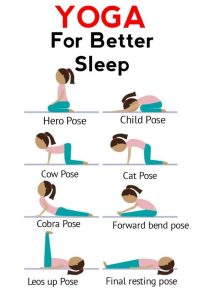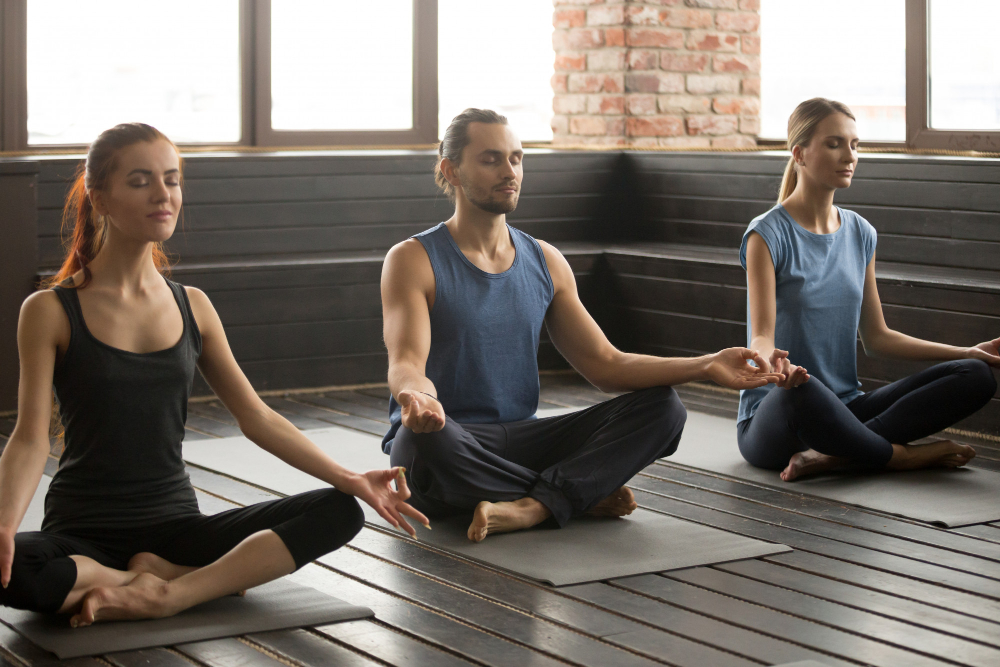Life these days can be really hectic, like a spinning top. Finding peaceful sleep can feel like trying to catch morning mist. But don’t worry, there’s a special thing called yoga that can help. It’s like a hidden treasure that can calm your mind and improve your sleep. So, let’s explore some yoga poses and stretches together that can lead us to a good night’s sleep.
Thank you for reading this post, don't forget to subscribe!
Improve Sleep Quality with Yoga: The Science Behind It
The practice of yoga involves gentle stretches, controlled breathing, and meditation, all of which have been shown to activate the parasympathetic nervous system – the body’s “rest and digest” response. By engaging in yoga before bed, you can effectively transition your body from the stresses of the day to a state of relaxation, priming it for a more rejuvenating sleep experience.
Yoga Poses for Deep Sleep
Certainly! Here are five yoga poses specifically designed to promote deep sleep:
- Balasana (Child’s Pose):
- Begin on your hands and knees in a tabletop position.
- Sit back on your heels, extending your arms forward and resting your forehead on the mat.
- Breathe deeply and hold the pose for several breaths, allowing your body to relax and release tension, especially in your back and shoulders.
- Viparita Karani (Legs-Up-The-Wall Pose):
- Sit sideways against a wall and lie down, extending your legs up the wall.
- Relax your arms by your sides or on your belly.
- Breathe deeply and hold the pose for 5-10 minutes, allowing blood to flow back to your heart and calming your nervous system.
- Supta Baddha Konasana (Reclining Bound Angle Pose):
- Lie on your back and bring the soles of your feet together, letting your knees drop open to the sides.
- Place cushions or bolsters under your knees for support if needed.
- Breathe deeply and hold the pose for 5-8 breaths, feeling a gentle stretch in your hips and groin.
- Savasana (Corpse Pose)
- Lie flat on your back with your arms by your sides and legs comfortably spread.
Close your eyes, relax your whole body, and focus on your breath.
- Breathe deeply and hold the pose for 5-10 minutes, allowing your body and mind to completely unwind.
- Pranayama (Breath Awareness):
- Find a comfortable seated position.
- Inhale deeply through your nose, allowing your abdomen to rise.
- Exhale slowly and completely, feeling your abdomen fall.
- Continue this deep, rhythmic breathing for several minutes, calming your mind and promoting relaxation.
Practicing these yoga poses before bedtime can help ease your body and mind into a state of relaxation, making it easier to transition into a deep and restful sleep. Remember to focus on your breath and maintain a sense of mindfulness throughout each pose.
Life these days can be really hectic, like a spinning top. Finding peaceful sleep can feel like trying to catch morning mist. But don’t worry, there’s a special thing called yoga that can help. It’s like a hidden treasure that can calm your mind and improve your sleep. So, let’s explore some yoga poses and stretches together that can lead us to a good night’s sleep.
Improve Sleep Quality with Yoga: The Science Behind It
The practice of yoga involves gentle stretches, controlled breathing, and meditation, all of which have been shown to activate the parasympathetic nervous system – the body’s “rest and digest” response. By engaging in yoga before bed, you can effectively transition your body from the stresses of the day to a state of relaxation, priming it for a more rejuvenating sleep experience.
Yoga Poses for Deep Sleep: Unwinding for Tranquility
Certainly! Here are five yoga poses specifically designed to promote deep sleep:
- Balasana (Child’s Pose):
- Begin on your hands and knees in a tabletop position.
- Sit back on your heels, extending your arms forward and resting your forehead on the mat.
- Breathe deeply and hold the pose for several breaths, allowing your body to relax and release tension, especially in your back and shoulders.
- Viparita Karani (Legs-Up-The-Wall Pose):
- Sit sideways against a wall and lie down, extending your legs up the wall.
- Relax your arms by your sides or on your belly.
- Breathe deeply and hold the pose for 5-10 minutes, allowing blood to flow back to your heart and calming your nervous system.
- Supta Baddha Konasana (Reclining Bound Angle Pose):
- Lie on your back and bring the soles of your feet together, letting your knees drop open to the sides.
- Place cushions or bolsters under your knees for support if needed.
- Breathe deeply and hold the pose for 5-8 breaths, feeling a gentle stretch in your hips and groin.
- Savasana (Corpse Pose)
- Lie flat on your back with your arms by your sides and legs comfortably spread.
Close your eyes, relax your whole body, and focus on your breath.
- Breathe deeply and hold the pose for 5-10 minutes, allowing your body and mind to completely unwind.
- Pranayama (Breath Awareness):
- Find a comfortable seated position.
- Inhale deeply through your nose, allowing your abdomen to rise.
- Exhale slowly and completely, feeling your abdomen fall.
- Continue this deep, rhythmic breathing for several minutes, calming your mind and promoting relaxation.
Practicing these yoga poses before bedtime can help ease your body and mind into a state of relaxation, making it easier to transition into a deep and restful sleep. Remember to focus on your breath and maintain a sense of mindfulness throughout each pose.

Ref – of image https://in.pinterest.com/pin/409546159879702387/
Techniques and Methods for Yoga Poses for Deep Sleep:
To maximize the benefits of yoga poses for deep sleep, consider the following techniques and methods:
- Breath Awareness: Focus on deep, diaphragmatic breathing throughout your practice. Inhale slowly through your nose, allowing your abdomen to rise, and exhale fully. This triggers the relaxation response and calms the mind.
- Hold Poses Mindfully: When in a pose, hold it with mindfulness. Focus on your breath and sensations in your body. This mindfulness helps release tension and promotes relaxation.
- Gentle and Slow Movements: Avoid quick, forceful movements that might increase heart rate and energy. Embrace slow, gentle transitions between poses to maintain a sense of calm.
- Modify as Needed: Listen to your body and modify poses if necessary. Use props like blocks and bolsters to support your body and make the poses more accessible.
- Practice Before Bed: Aim to practice yoga poses for deep sleep at least 1-2 hours before bedtime. This allows your body to wind down and prepares you for rest.
- Create a Relaxing Environment: Practice in a calm, quiet space with dim lighting. Consider using soothing music or soft instrumental sounds to enhance the relaxation experience.
- Consistency is Key: Consistent practice yields better results. Try to incorporate these poses into your bedtime routine regularly to experience the cumulative benefits.
- Mind-Body Connection: As you move through each pose, focus on the mind-body connection. Tune into how each stretch or movement feels and observe the calming effects it has on your mind.
Also read : https://solutions4sleep.com/sleep-remedies/
Benefits of Yoga Before Bed:
Practising yoga poses specifically designed for promoting deep sleep offers a multitude of benefits that extend beyond just a good night’s rest. These poses have the power to address physical tension, calm the mind, and prepare the body for relaxation, leading to improved sleep quality and overall well-being. Some of the key benefits include:
- Muscle Relaxation: Yoga poses help release tension in muscles and joints, reducing physical discomfort that might interfere with sleep.
- Stress Reduction: The deliberate focus on breath and movement in yoga triggers the body’s relaxation response, reducing stress hormones and promoting mental calmness.
- Nervous System Balance: Yoga helps balance the sympathetic (fight-or-flight) and parasympathetic (rest-and-digest) nervous systems, creating a conducive environment for sleep.
- Mindfulness and Meditation: Many yoga poses incorporate mindfulness and meditation techniques, which can quiet the mind and alleviate racing thoughts that often disrupt sleep.
- Improved Circulation: Certain poses encourage blood circulation, ensuring proper oxygen and nutrient supply to tissues, aiding in relaxation and restoration.
- Spinal Mobility: Yoga poses often involve spinal stretches and twists, which can alleviate tension and improve spinal health, contributing to better sleep posture.
- Enhanced Digestion: Gentle twists and poses that massage the abdomen can help facilitate digestion, preventing discomfort that might disturb sleep.
- Increased Body Awareness: Yoga cultivates a heightened sense of body awareness, making you more attuned to physical sensations and better equipped to identify areas of tension or discomfort.
Incorporating these yoga poses and stretches into your bedtime routine can transform your sleep experience. The combination of gentle stretches, controlled breathing, and relaxation techniques can help release both physical and mental tension, fostering the ideal conditions for restful slumber. Remember, consistency is key. By dedicating a few minutes each evening to these calming practices, you can create a sanctuary of tranquility that leads to deep, restorative sleep. As always, consult with a healthcare professional before beginning any new exercise routine, especially if you have existing health conditions. With time and practice, these yoga poses can become your gateway to embracing the beauty of a peaceful night’s sleep.
Remember, yoga is a holistic practice, and its benefits go beyond physical flexibility. Embrace the mental and emotional aspects as well, allowing your practice to create a sense of overall well-being that extends into your sleep patterns. As with any new exercise routine, consult a healthcare professional, especially if you have underlying health concerns.
Ref : 1.https://www.everydayhealth.com/fitness/yoga-poses-and-exercises-for-better-sleep-tonight/
3.https://www.truescoopnews.com/stories/top-yoga-poses-insomnia-restful-sleep



